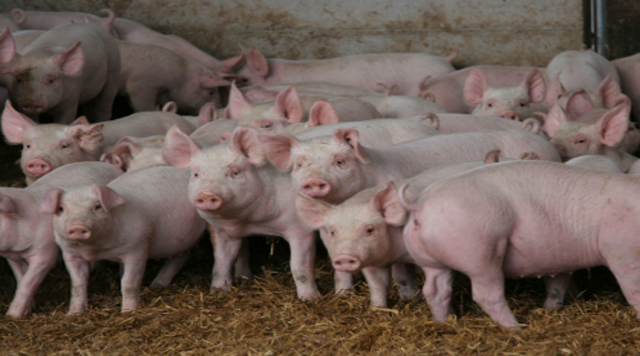

Camborough pigs are praised for their excellent meat quality that is to say; not too much fat, better resistance to parasites, higher growth rate, better mothering ability and high average litter size of 14 piglets. It is possible for farmers rearing five sets of five Camborough sows to meet contractual obligation of supplying 70 piglets per month to a buyer if all the basic husbandry practices in the enterprise plan are followed. It is these practices that ensure that a higher percentage of gilts and sows conceive in a period of breeding, a higher proportion of pregnant pigs deliver successfully, a higher proportion of piglets survive, all weaners are fattened and sold.
Although natural breeding with carefully selected breeding males and females are common, artificial insemination using semen from studded boars is becoming more available service to farmers in Uganda.
Camborough pigs grow really fast. At four months, the boars have attained a weight of 120 kilogrammes. They have considerably less fat, and the sows are great mothers. They do not lose their babies, they feed the babies well and they have enough milk. They give birth to an average of 14 piglets and that’s three times a year. They are also resistant to diseases if managed well.
Pig enterprise plan
This encompasses logical description of what a farmer intends to do. All pig farmers including those who cannot read and write are advised to have pig enterprise plan which should clearly include; description of farm location, management structure and farm resource inventory. The objective of the farm such as when to sell piglets, baconers, breeding gilts, mature boar or sown should be well laid out.
Farmers venturing in Camborough piggery ought to have a production plan, that is how many and when the farmer intends to have the type of pigs ready for sell to potential buyer.
Proper housing: A good Camborough pigsty should facilitate drainage of wastes, permit adequate ventilation, be made of strong and affordable materials, should not leak and have feeding and watering troughs.
Feeds and feeding
Adequate feeding is intended to ensure faster growth, timely onset of puberty in gilts, increase conception rate at first oestrus, reduce time interval between births in sows, and finally improve health and vigour of piglets. Feeds are palatable stuffs when eaten. They provide nutrients such as carbohydrates, proteins, lipids, minerals and vitamins for maintaining the body, development, growth, reproduction and production. Feeds accounts for more than 70 per cent of piggery operational costs. It is, therefore, important for a pig farmer to always seek to provide nutritionally balanced, safe, palatable and economical feed.
Try out these feed ingredients: grains, rice bran, maize bran, sun flower cake, cotton cake, legumes (beans, soybeans, peanuts and peas), root crops, cassava, sweet potatoes , yams, silver fish (mukene), legume pastures (Centrocema, Glycine, Comellina, Wandering Jew), Lablab, Amaranths’spp, fodder trees and kitchen leftovers if you are feeding your Camborough.
Health guidelines
Every commercial pig farmer should draw up a herd health programme with the help of veterinary extension worker. This outlines critical veterinary activities scheduled and implemented to optimise health and productivity of the Camborough pigs. This type of pigs remain vulnerable to diseases such as African swine fever and brucellosis. Agronomists advice farmers to immediately treat the pigs against injuries, worms, ticks, fleas, other parasites and infections.
Recommendations
Farm workers should be provided with overalls, handwashing facilities and footwear that is easy to disinfect such as gumboots. Everyone including the farm owner should be subjected to very high standards of hygiene. The other human transmitters of swine fever are pig traders who buy animals from all over the country and deliver to the slaughterhouse or distribute to other farmers. These people should never be allowed into the pig sheds unless they change clothing and disinfect themselves before entering the pig houses.
 Contact Jaguza Support
Contact Jaguza Support